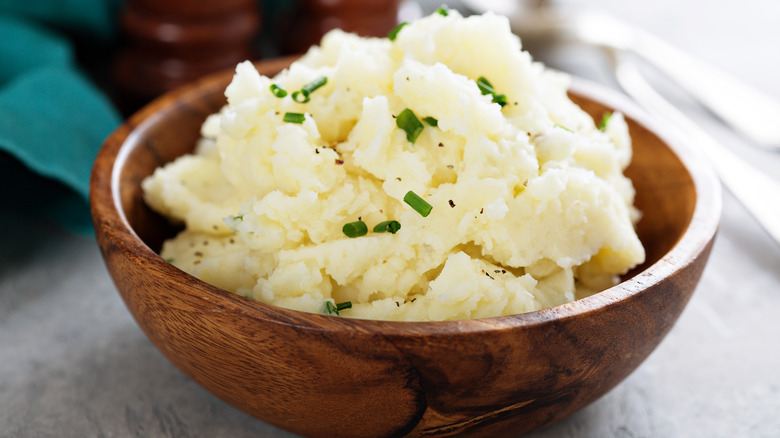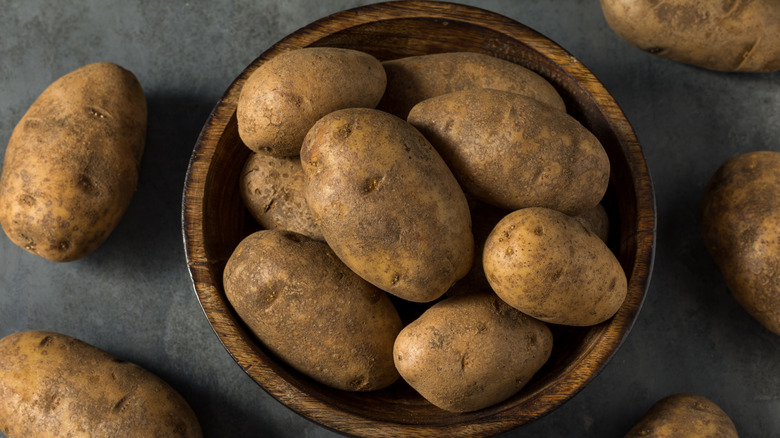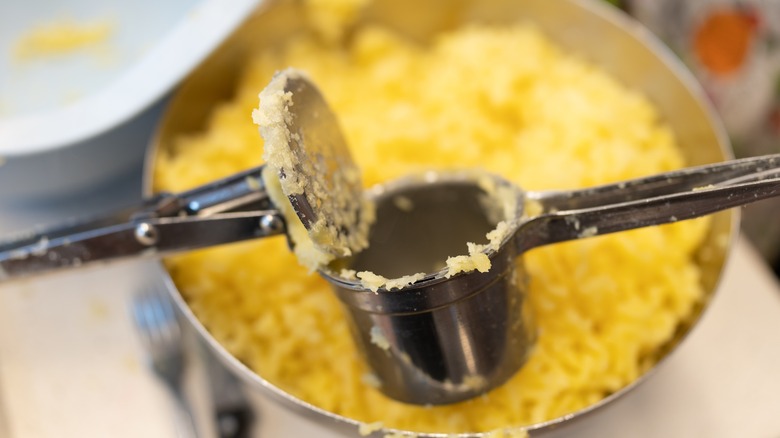For The Fluffiest Mashed Potatoes, Don't Boil Them In Water
You can never go wrong with rich and creamy mashed potatoes. But if you're craving an extra fluffy batch, don't start by boiling a pot of water. Instead, try steaming your spuds to create an ultra light mash that pairs well with just about anything.
Steaming potatoes can preserve their natural taste, which is often diluted by water when boiling. Plus, it's a faster and easier method, whether you're making small or large batches. You only have to boil a few inches of water to create the steam, no matter how many spuds you're cooking. Plus, without needing to drain or dry the starchy veggie, you won't have to worry about watery mashed potatoes in the end. To try this technique, simply place cubed potatoes in a steamer basket and cook for about 20 minutes, or until a fork can easily pierce through them.
Your potatoes can also be infused with extra taste by flavoring the water used for steaming. Start with a broth or stock, then feel free to dress it up with additional seasonings like spices and herbs. You can even throw in fresh lemon peel and a few cloves of garlic for some zest. Or look to what drinks you're serving with dinner and take inspiration. Wine or beer can easily be used to steam the spuds. Once you're done cooking them, keep the liquid to create a flavorful pan sauce or gravy.
Preparation steps for the lightest mashed potatoes
While the cooking technique of steaming is important for airy mashed potatoes, the steps leading up to it also can make or break your final dish. First, you'll want to start with the correct kind of spuds for fluffy mashed potatoes. Avoid waxy varieties, like red or fingerling, and instead reach for less dense types, such as russet or white potatoes.
Overall, russet potatoes are the best choice for a lightly textured mash. They have a naturally mealy consistency, which means they'll fall apart easily once steamed. This results in less effort to break them apart and therefore less likelihood of ending up with a gluey side dish from too much starch releasing.
Once you've settled on what type of potato to use, get to peeling and cubing. Then, one of the most important steps you shouldn't skip, soak the spuds in cold water to remove any extra starch. This is the secret prep technique for ultra fluffy mashed potatoes. If you don't have the time to soak beforehand, giving the potatoes a quick rinse can also help. Simply use a colander to run water over them until it runs clear.
More tips for whipping up the fluffiest mashed potatoes
Once the potatoes are cooked, there's one more step until you're enjoying your dish. To actually mash them, use a ricer or food mill to break them apart while not releasing too much starch. Don't have either of these tools on hand? A cooling rack works similarly, shearing through the potatoes without causing a gummy texture.
When making the dish, there are some appliances worth skipping, however, for a fluffier mouthfeel. Quickly blending everything together in a food processor might be tempting, but the end result will be super gluey potatoes with a texture similar to stretchy cheese. Hand mixers can have similar disappointing outcomes, but stand mixers tend to make for a less starchy mashed potato (though not nearly as fluffy as a ricer or food mill).
Finally, when your potatoes are ready to be mixed with all the things that make them extra delicious, ensure that those ingredients are close to room temperature. If mix-ins like milk, cream, or butter are super cold, it can make it harder to combine everything into a cohesive dish. And, the longer it takes you stir everything in, the higher likelihood of starch releasing to create a goopy dish. Either sit out your measured ingredients to warm them up, or give each a quick zap in the microwave to come to the right temperature.



